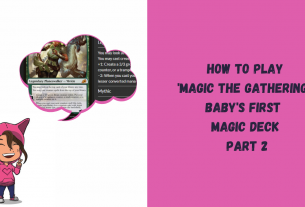
New to Kickstarter? Check out our crowdfunding primer, and visit our Kickstarter curated page for more projects we love.
Note: This review is based on a prototype copy which may be subject to change before final copies are shipped.
Components
- 36 Action Cards
- 72 Number Cards
- 1 Instruction Book with rules for all seven games
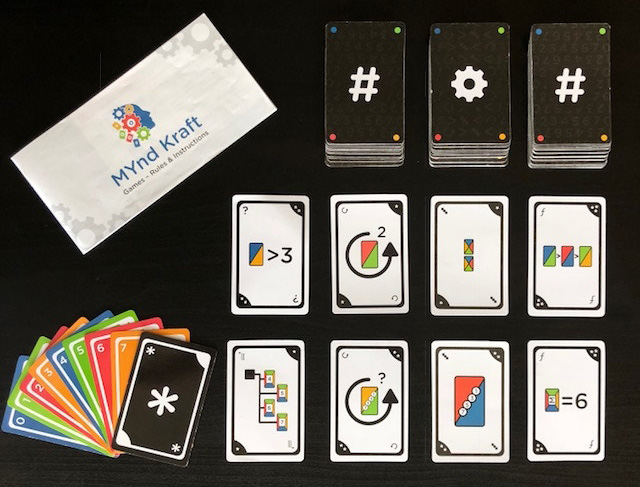
How Do You Play MYnd Kraft?
The Cards
All the MYnd Kraft games are played using the two card types in the deck. These are Action Cards and Number Cards.
There are eight different types of Action Cards in the deck:
Introductory Pack Cards:
- Conditional Statement (6)
- For-Loop (6)
- Data Structure: Array (6)
- Switch-Case Statement (6)
Advanced Pack Cards
- While-Loop (3)
- Data Structure: Dictionary (3)
- Function (6, 3 each of two types)
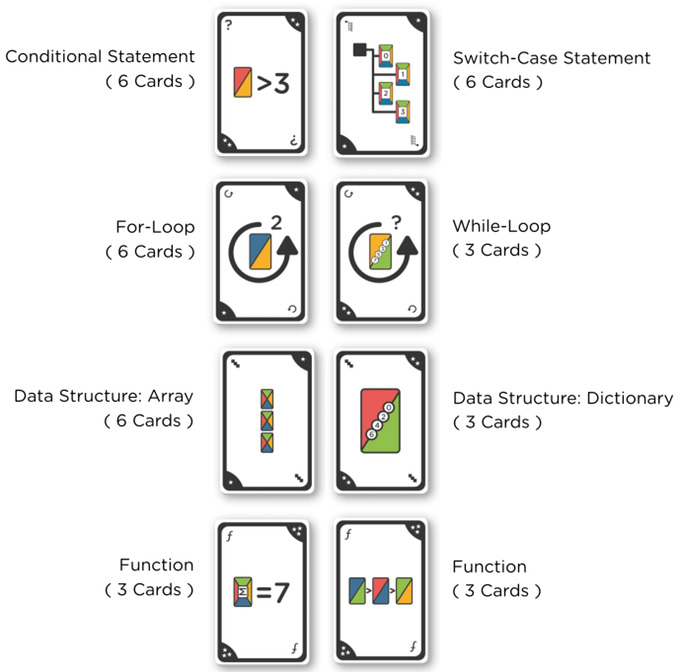
There are also 72 Number Cards in the deck. These come in four colors (red, blue, green, and yellow) with two sets of cards in each color. Each set contains eight cards numbered from 0 to 7 so there are two cards of each number and color (e.g. two red number fours, two green number six’s etc). There are also eight black Asterisk Cards which are wild and can be used in place of any number card of any color.
The Games
The Action Cards are used with the Number Cards to play the seven different MYnd Kraft games which have various levels of difficulty. Some are recommended for older players, while some can be played by kids as young as seven.
Ezy Codr: An introductory game which helps explain how Action Cards are solved. Players take turns solving Action Cards and scoring points. (2-6 players age 7 and up)
Speedy Monstr: Players race to solve action cards faster than their opponents. (2-4 players age 7 and up)
Memry Flipothon: A memory game where Action Cards and flipped over one at a time forcing players to remember their location in order to solve them. (2-4 players age 7 and up)
Decode: A strategy game where players must score the most points by thinking about different ways the same Action Card could be solved. (2-4 players age 11 and up)
Codr Pokr Match: A poker-style game where players compete to win a pot using game theory. (4-7 players age 11 and up)
Codr League: A team game where teams of two work together to solve as many Action Cards as possible (4-6 players age 11 and up)
Cobble the Code: A strategy game based on the tile placement mechanism. (2-6 players age 11 and up)
Each Action Card presents a problem which can be solved using the Number Cards. Every card except the Asterisk Cards has a number of stars in the top right/bottom left corners and these stars indicate the points value of the card. Players solve Action Cards and keep them, along with the Number Cards used to solve them. At the end of the game, the players add up the number of stars on all their cards and the player with the most stars wins.

Action Card Examples
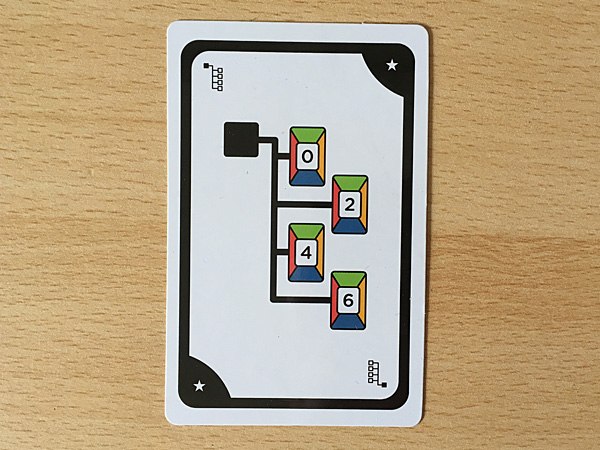
This Switch Card requires one Number Card to be played. The Number Card must have the same value as one of the values specified (in this example, 0, 2, 4, or 6) and can be any color because all four colors are shown.
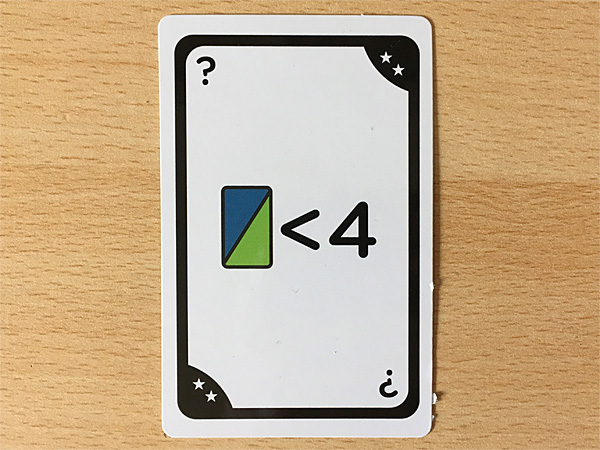
This Condition Card requires one Number Card to be played. The Number Card must have a value below four, and be either blue or green.

This Loop Card requires two Number Cards to be played (the number shown on the card). They can be of any value but must be either yellow or green.
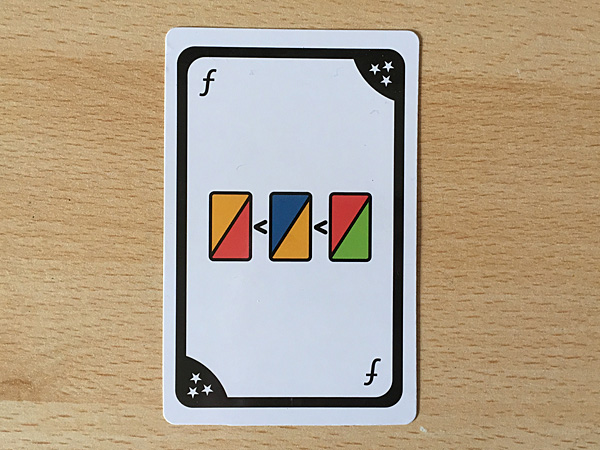
This Function Card requires three Number Cards to be played. A red or green card which has a value higher than a blue or yellow card which, in turn, has a value higher than a yellow or red card.
Why Should You Play MYnd Kraft?
With seven games in one box, MYnd Kraft is definitely good value for money. It also has great flexibility with games that can accommodate anywhere between two and seven players so you’ll be able to play something no matter the size of your group. The different difficulty levels in the games mean that MYnd Kraft will grow with your child over many years, so this isn’t something they will outgrow quickly as with many educational games, and at just $19/£15 (or $17/£13 for early birds who back the campaign within the first 48 hours) it’s great value for money.
That being said, there are some issues. We struggled to understand the instructions for some of the Action Cards in our prototype copy and felt they could have been explained much better – perhaps with illustrative examples of Number Cards that would successfully solve them. The game is also not at all friendly to anyone suffering from color blindness. There are no symbols or patterns on the Number Cards to differentiate them, nor is there anything on the Action Cards to help with this. I’d love to see this issue rectified as at least one member of my regular gaming group will currently be unable to play MYnd Kraft with us because of this design flaw.
My eight-year-old son and I played several of the MYnd Kraft games together including Ezy Codr, Speedy Monster, and Memry Flipothon and we found them all to be a lot of fun. Whether or not they’re really helping to teach him programming concepts as the designer suggests is somewhat up for debate. Personally, I found that the games were more focused on teaching math skills and color matching than anything more specifically programming-focused, but perhaps in time, I’ll see the benefits and it will certainly help my son gain familiarity with some of the unusual language around programming.
Undoubtedly, MYnd Kraft helps with problem-solving, logic skills, and developing strategic and critical thinking – none of which are to be brushed aside. The designers have put together a Guide to Programming Concepts Introduced in the Game which is available as a PDF and is a great resource for teachers and parents, especially those not familiar with programming concepts. This guide is available via the Kickstarter page and the Mynd Kraft website.
Verdict
MYnd Kraft is a fun game with huge amounts of potential, both through the seven games already included and the opportunity to create your own from the various Action and Number Cards. While I only have the prototype to refer to, the packaging is minimal and mostly recyclable making it one of the more environmentally friendly games I have opened recently.
MYnd Kraft makes STEM learning fun in many ways thanks to the variety it provides – whether you prefer a fast-paced challenge against your friends, working together in teams, complex strategy, or just a relaxing puzzle game, there’s something for everyone in its seven different game choices. Hopefully the instruction issues will be cleared up by the time the finished product reaches backers, and I would hope to see something included for color blind players in the future, but for now, this is one worth backing.
Follow Mynd Kraft on Facebook for more information.
GeekMom received this game for review purposes. This is a sponsored post.
Podcast: Play in new window | Download

